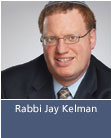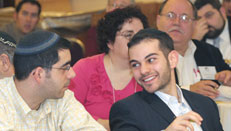 |
||||||||||||
| Weekly Parsha | ||
| Current Week | ||
| Parsha Archives | ||
| Business Ethics | ||
| Dr. Malamet Speaks Out | ||
| TiM MP3 Library | ||




A Thought for the Week with Rabbi Jay Kelman
|
 On Purim the world is turned upside down. A powerless people living in exile manage to instill fear in others leading many to convert to Judaism. Drinking, parties, levity are the norm this one day a year. Even our tzniut is somewhat stripped away. The Shulcahn Aruch records a practice of cross dressing of males and females. It is a day, perhaps the only day which is celebrated with emphasis on the physical, reminding us of the desire of Haman to physically destroy the Jewish people. Yet the topsy turvy nature of Purim has a more enduring legacy. "The grandchildren of Sancheriv taught Torah in public, the grandchildren of Haman taught Torah in Bnei Brak". Descendants of the most wicked of people are involved in the most holy of tasks. On its most simplistic level we have here a stark application of the Biblical mandate that "children shall not die for the sins of their fathers". Yet as paradoxical as it sounds, it seems that their great ability at teaching Torah was a direct result of their being descendant from some of the most evil people in history. A quick look at the world around us will confirm what psychologists have noted. The desire to inflict harm is much greater than the desire to do good. How often does one find an excuse not to do something positive and yet how rare that one lets bad weather get in the way of the desire to get back at somebody. If that power for evil can be harnessed for positive purposes then the potential for good is enormous. It is this idea that the Rabbis had in mind when they declared that it is possible for repentance to convert "sins into merits". The efforts expended in sin can serve as the springboard for tremendous mitzvah observance. Most often evil people are quite talented, unfortunately they have misplaced priorities. Yet these abilities are often passed down to children, both by nature and nurture, who may use these abilities in a most positive sense. It is precisely the descendants of Amalek and (his descendant) Haman, as the personification of evil, that may potentially be the source of great good. The Torah requires us to wipe out Amalek from "under the heavens". Rav Kuk notes that above the heavens, i.e. if the Amaleks of this world do teshuva they have the potential to be the source of goodness. Purim is the holiday of hester panim , where all is hidden, a notion reflected in Esther's name. A story describing the political goings on in ancient Persia, which on the surface is devoid of religious inspiration, is in reality one of reaffirmation of Torah. It is Purim our Sages note, when the Jewish people willingly accepted the oral law, the law hidden in between the lines of written law. Though G-d's name is nowhere to be found in the megillah, His presence can be felt throughout. What we often think we understand is often truly hidden from us, a message readily brought home in the current economic times. We wear costumes on Purim highlighting that often what we see is very different than what truly is. The megillah ends by describing the tax policies instituted by Achasverosh. Life continued in Persia as if nothing had really happened. In fact this is one of the reasons noted by our Sages as to why Halllel is not recited on Purim. Yet while it appeared on the surface as if not much had changed just beneath it Jewish history was unfolding. Not only was the Temple about to be rebuilt, a new epoch was beginning, one marked by the primacy of the oral law. On Purim more than we celebrate the downfall of Haman or the rise of Mordecahi, we celebrate the fact that, if not Haman himself then at least his descendants, could play positive roles in Jewish life. This is an important message to keep in mind as we face our own current Haman who like his Persian ancestor has plans to "destroy, kill and eradicate all the Jews from young to old, men woman and children on one day" (3:13). We must follow in the footsteps of Mordechai and Esther "gather together all the Jewish people" (4:16) confident that "salvation will come to the Jewish people". |
|
|

 |
 |